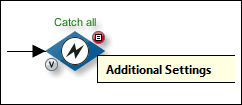Throw
Usage
A Throw module produces an error, which can be caught and handled by the error exit of a scope, for example. If needed, an entry in the Queue Manager is created and an e-mail is sent to a configurable recipient.
By using a Throw module, you can define errors yourself to catch and handle them, for example, with the error exit of a Scope. You define the name of the error and the variable, in which the information about the error should be written, after having added the Throw to the workflow.
When executing the Throw, an entry is created in the Queue Manager by default and an error mail is sent. You can switch this behavior off.
When testing, the error is displayed in the default error dialog.
As long as you have not configured the module, the Additional Settings icon is colored in red.

Adding Queue Manager entries in transient mode
Proceed as follows
-
Open the workflow with the Throw module for editing.
-
In the Execution dialog, activate the Transient mode.
-
Check the In memory (without transaction mode).
-
Click Finish to save the changes.
-
Open the Additional settings dialog of the Throw module to be configured.
-
Activate the checkbox Create entry in Queue Manager and send error mail.
-
Click OK to save the changes.
-
Publish the workflow.
→ If an error occurs, a Queue Manager entry is created.
Dialog Additional Settings for the Throw Control
Call up
By clicking the Additional Settings icon after inserting the Throw control into the workflow.
Options
-
Error name (ISErrorKey)
Name of the error.
The name is used for matching the error to the corresponding error exit at the scope.
-
Error text (ISErrorString)
-
Fixed value
Static error message
-
From variable value
For selecting the variable from which the error message is to be read.
-
-
Create entry in Queue Manager and send error mail
If activated, the error causes an entry in the Queue Manager. Additionally, an e-mail is sent.
For information about configuring the e-mail’s recipient, refer to After incorrect execution e-mail to.
